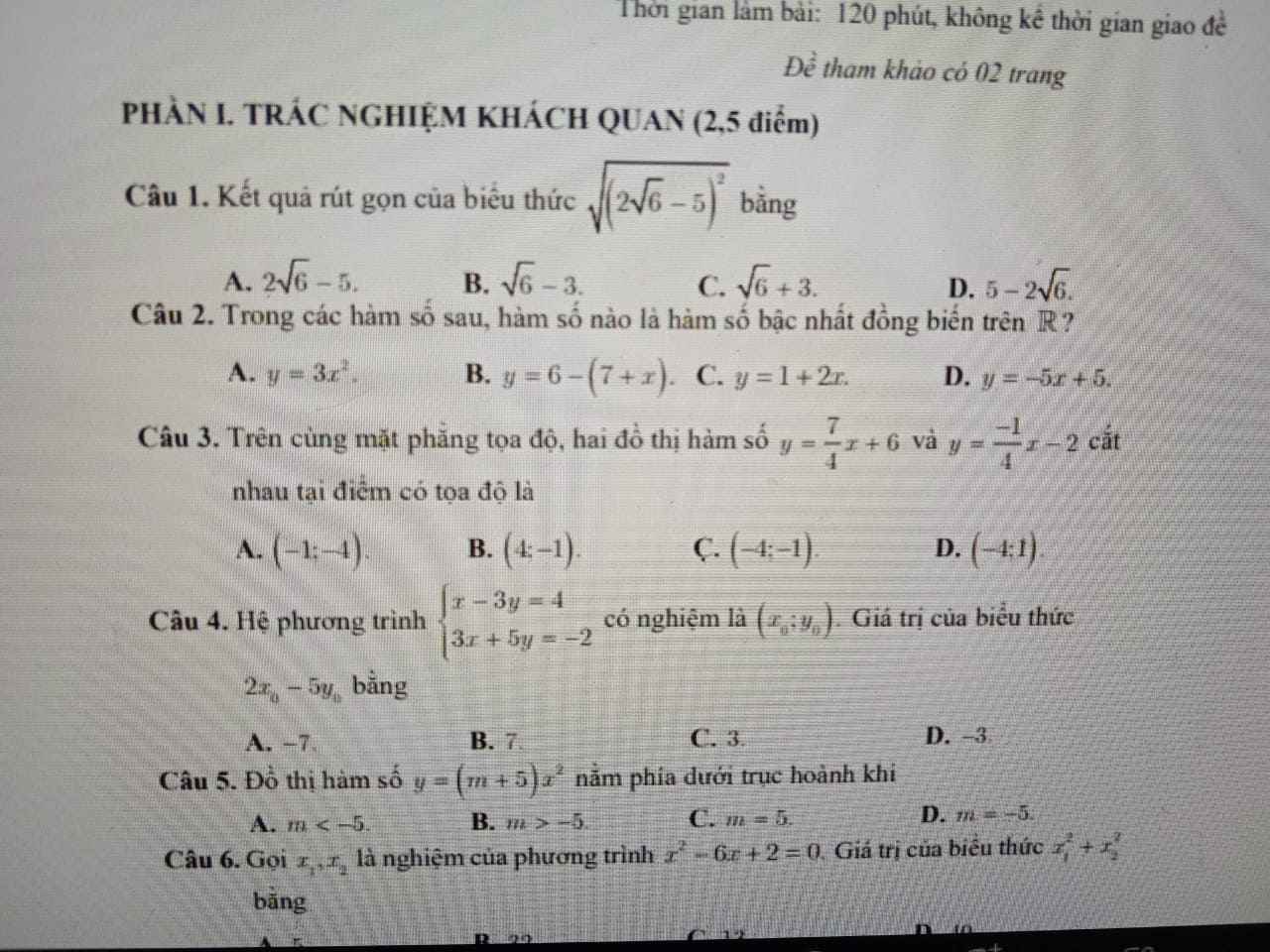
Hãy nhập câu hỏi của bạn vào đây, nếu là tài khoản VIP, bạn sẽ được ưu tiên trả lời.


Theo tính chất 2 tiếp tuyến: \(\left\{{}\begin{matrix}AC=CM\\BD=DM\end{matrix}\right.\) \(\Rightarrow\dfrac{CM}{DM}=\dfrac{AC}{BD}\)
Mặt khác do AC//BD (cùng vuông góc AB)
\(\Rightarrow\dfrac{AC}{BD}=\dfrac{CN}{BN}\) (Talet) \(\Rightarrow\dfrac{CM}{DM}=\dfrac{CN}{BN}\Rightarrow MN||BD\)
Cũng theo Talet: \(\dfrac{CN}{BN}=\dfrac{AN}{DN}\Rightarrow\dfrac{BC}{BN}=\dfrac{AD}{DN}\Rightarrow\dfrac{BN}{BC}=\dfrac{ND}{AD}\) (1)
\(\dfrac{MN}{AC}=\dfrac{ND}{AD}\) ; \(\dfrac{NH}{AC}=\dfrac{BN}{BC}\) (2)
(1); (2) \(\Rightarrow\dfrac{MN}{AC}=\dfrac{NH}{AC}\Rightarrow MN=NH\)



Mình làm dựa vào những gì đề đã có nhé. Câu nào đề thiếu mình sẽ không giải.
1. Kẻ đường kính AK của đường tròn (O). Do A là điểm chính giữa cung BC nên OA là đường trung trực BC. Mặt khác I là trung điểm BC nên O, A, I thẳng hàng \(\Rightarrow\angle BIA=90^o.\)
Do AK là đường kính đường tròn (O) nên \(\angle ABK=90^o\Rightarrow AB^2=AI\cdot AK.\) (hệ thức lượng)
Xét $\Delta AID$ và $\Delta AEK$ có
$\angle A:$ chung
$\angle AID =\angle AEK=90^o$
\(\Rightarrow\Delta AID\sim\Delta AEK\Rightarrow\dfrac{AI}{AE}=\dfrac{AD}{AK}\Rightarrow AD\cdot AE=AI\cdot AK=AB^2\) (đpcm)
2. Xét tứ giác AHIC có
\(\angle AHC=\angle AIC=90^o\Rightarrow\) AHIC là tứ giác nội tiếp \(\Rightarrow\) A, I, C, H đồng viên (đpcm).
3. Chưa đủ dữ kiện để giải.

1) Vì x=25 thỏa mãn ĐKXĐ nên Thay x=25 vào biểu thức \(A=\dfrac{\sqrt{x}-2}{x+1}\), ta được:
\(A=\dfrac{\sqrt{25}-2}{25+1}=\dfrac{5-2}{25+1}=\dfrac{3}{26}\)
Vậy: Khi x=25 thì \(A=\dfrac{3}{26}\)
2) Ta có: \(B=\dfrac{\sqrt{x}-3}{\sqrt{x}+1}+\dfrac{2x+8\sqrt{x}-6}{x-\sqrt{x}-2}\)
\(=\dfrac{\left(\sqrt{x}-3\right)\left(\sqrt{x}-2\right)}{\left(\sqrt{x}-2\right)\left(\sqrt{x}+1\right)}+\dfrac{2x+8\sqrt{x}-6}{\left(\sqrt{x}-2\right)\left(\sqrt{x}+1\right)}\)
\(=\dfrac{x-5\sqrt{x}+6+2x+8\sqrt{x}-6}{\left(\sqrt{x}-2\right)\left(\sqrt{x}+1\right)}\)
\(=\dfrac{3x+3\sqrt{x}}{\left(\sqrt{x}-2\right)\left(\sqrt{x}+1\right)}\)
\(=\dfrac{3\sqrt{x}\left(\sqrt{x}+1\right)}{\left(\sqrt{x}-2\right)\left(\sqrt{x}+1\right)}\)
\(=\dfrac{3\sqrt{x}}{\sqrt{x}-2}\)

Bạn để ý \(\left(2\sqrt{x}-1\right)\left(\sqrt{x}+4\right)=2x+7\sqrt{x}-4\)
Bạn chỉ cần quy đồng lên rồi tính thôi.
9) Ta có: \(\dfrac{\sqrt{x}+2}{x-5\sqrt{x}+6}-\dfrac{\sqrt{x}+3}{2-\sqrt{x}}-\dfrac{\sqrt{x}+2}{\sqrt{x}-3}\)
\(=\dfrac{\sqrt{x}+2+x-9-x+4}{\left(\sqrt{x}-2\right)\left(\sqrt{x}-3\right)}\)
\(=\dfrac{\sqrt{x}-3}{\left(\sqrt{x}-2\right)\left(\sqrt{x}-3\right)}\)
\(=\dfrac{1}{\sqrt{x}-2}\)


Câu IV:
1) Xét tứ giác BFEC có
\(\widehat{BFC}=\widehat{BEC}\left(=90^0\right)\)
\(\widehat{BFC}\) và \(\widehat{BEC}\) là hai góc cùng nhìn cạnh BC
Do đó: BFEC là tứ giác nội tiếp(Dấu hiệu nhận biết tứ giác nội tiếp)
hay B,F,E,C cùng nằm trên 1 đường tròn(đpcm)











Kẻ đường kính AF, gọi G là trung điểm CF \(\Rightarrow\) G cố định. Nối GH cắt AN kéo dài tại J
ANCF nội tiếp \(\Rightarrow\widehat{ANC}+\widehat{AFC}=180^0\)
G và H là trung điểm các dây CF, CN \(\Rightarrow\left\{{}\begin{matrix}OH\perp CN\\OG\perp CF\end{matrix}\right.\)
\(\Rightarrow OHCG\) nội tiếp \(\Rightarrow\widehat{OHG}=\widehat{OCG}\) (cùng chắn OG)
Mà \(\widehat{OCG}=\widehat{AFC}\) (2 góc đáy tam giác OCF cân)
\(\Rightarrow\widehat{OHG}=\widehat{AFC}\Rightarrow\widehat{OHG}+\widehat{ANC}=180^0\)
Lại có \(\widehat{GHC}=\widehat{NHJ}\) (đối đỉnh), \(\widehat{OHG}+\widehat{GHC}=90^0\)
\(\Rightarrow\widehat{OHG}=90^0-\widehat{GHC}=90^0-\widehat{NHJ}\)
\(\Rightarrow\widehat{ANC}+90^0-\widehat{NHJ}=180^0\Rightarrow\widehat{ANC}-\widehat{NHJ}=90^0\)
\(\Leftrightarrow\widehat{NJH}+\widehat{NHJ}-\widehat{NHJ}=90^0\Leftrightarrow\widehat{NJH}=90^0\)
Hay \(GH\perp AN\)
Mà \(IH\perp AN\Rightarrow I\) trùng J hay G;H;I thẳng hàng
\(\Rightarrow\) IH luôn đi qua G cố định
Do I \(AI\perp IG\Rightarrow I\) luôn thuộc đường tròn đường kính AG cố định
Hình vẽ: